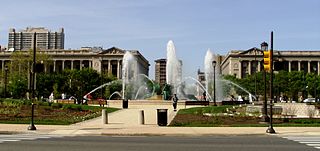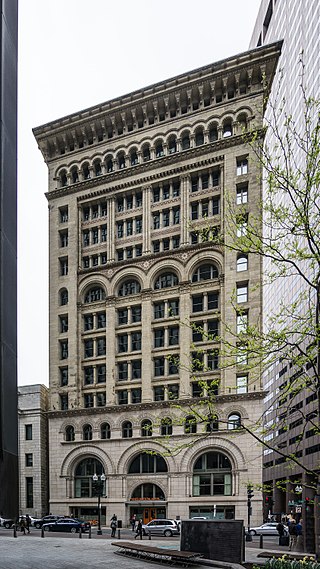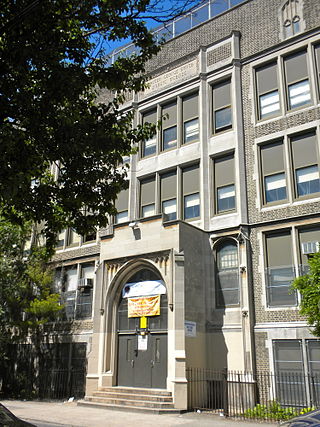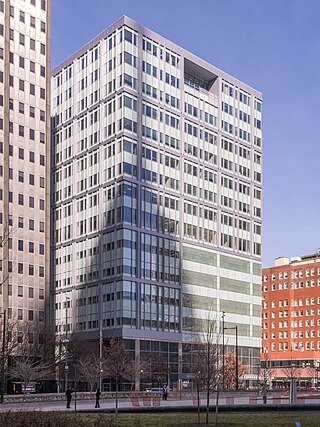
Center City includes the central business district and central neighborhoods of Philadelphia, Pennsylvania, United States. It comprises the area that made up the City of Philadelphia prior to the Act of Consolidation, 1854, which extended the city borders to be coterminous with Philadelphia County.

Logan Circle, also known as Logan Square, is an open-space park in Center City Philadelphia's northwest quadrant and one of the five original planned squares laid out on the city grid. The centerpiece of the park is the Logan Circle, a circular area centered on a large water feature, bounded by a traffic circle carrying 19th Street and the Benjamin Franklin Parkway with connections to 18th and 20th streets to the east and west and Race and Vine Streets to the south and north.

Old City is a neighborhood in Center City, Philadelphia, Pennsylvania, United States, near the Delaware River waterfront. It is home to Independence National Historical Park, a dense section of historic landmarks including Independence Hall, the Liberty Bell, the First Bank of the United States, the Second Bank of the United States, and Carpenters' Hall. It also includes historic streets such as Elfreth's Alley, dating back to 1703.

The African American Museum in Philadelphia (AAMP) is notable as the first museum funded and built by a municipality to help preserve, interpret and exhibit the heritage of African Americans. Opened during the 1976 Bicentennial celebrations, the AAMP is located in historic Philadelphia on Arch Street, a few blocks away from the Liberty Bell. It was formerly known as the Afro-American Historical and Cultural Museum.

Logan Square is a neighborhood in Philadelphia, Pennsylvania, United States. Bounded by Market Street on the south, Spring Garden Street on the north, Broad Street on the east, and the Schuylkill River on the west, it occupies the northwestern quadrant of Center City. The square for which it is named is one of the five squares central to William Penn's design for Philadelphia. Originally called Northwest Square, it was renamed in honor of James Logan, an 18th-century mayor of Philadelphia.

The Ames Building is located in Boston, Massachusetts. It is sometimes ranked as the tallest building in Boston from its completion in 1889 until 1915, when the Custom House Tower was built, but the steeple of the 1867 Church of the Covenant was much taller than the Ames Building. It is nevertheless considered Boston's first skyscraper. In 2007, the building was converted from office space to a luxury hotel. In 2020, the building was purchased by Suffolk University and converted into a student residence hall.

Roy Donahue "Don" Peebles is an American millionaire, real estate entrepreneur, author, national media commentator and political leader. Peebles is the founder, Chairman/CEO of The Peebles Corporation (TPC), a privately held real estate investment and development company he established in 1983.
The Philadelphia Register of Historic Places (PRHP) is a register of historic places by the Philadelphia Historical Commission. Buildings, structures, sites, objects, interiors and districts can be added to the list.

Morton Street is a street in southern Boston, Massachusetts, United States. It extends from the southeastern end of the Arborway in Jamaica Plain to Washington Street in the Lower Mills Village of Dorchester. Most of the road is a connecting parkway, signed as part of Massachusetts Route 203, that provides access to Boston's Emerald Necklace of parks. That portion of the road was listed on the National Register of Historic Places in 2005.

108 Leonard, formerly known as 346 Broadway, the New York Life Insurance Company Building, and the Clock Tower Building, is a residential structure in the Tribeca neighborhood of Manhattan in New York City, United States. Built from 1894 to 1898, the building was constructed for the New York Life Insurance Company. Stephen Decatur Hatch created the original plans while McKim, Mead & White oversaw the building's completion. The building occupies a city block bounded by Broadway to the west, Leonard Street to the north, Lafayette Street to the east, and Catherine Lane to the south. It is a New York City designated landmark and is listed on the National Register of Historic Places.

John Torrey Windrim was an American architect. His long time chief designer was W. R. Morton Keast.

Philosophical Hall is a historic building at 104 S. 5th Street in Center City, Philadelphia, Pennsylvania, USA. Located near Independence Hall, the building has, for over 200 years, been the headquarters of the American Philosophical Society. It was designated a National Historic Landmark in 1965 for its association with that organization.

The Walter George Smith School is a former American school building that is located in the Point Breeze neighborhood of Philadelphia, Pennsylvania.

Parkway West High School is an American public magnet high school that is located in the Mill Creek neighborhood of Philadelphia, Pennsylvania. It shares a site with the Middle Years Alternative School for the Humanities (MYA). Both schools are part of the School District of Philadelphia.
The following is a timeline of the history of the city of Philadelphia, Pennsylvania.

The Inquirer Building, formerly called the Elverson Building, is an eighteen-story building at the intersection of North Broad and Callowhill Streets in the Logan Square neighborhood of Center City Philadelphia, completed in 1924 as the new home for The Philadelphia Inquirer, a daily newspaper in the city, that was joined by the Philadelphia Daily News in 1957.

The Philadelphia Family Court is a specialized court of the Philadelphia, Pennsylvania, which has jurisdiction in the proceedings of domestic relations and juvenile law enforcement.
Peebles Corporation is a privately held real estate investment and development company. Headquartered in Miami Beach, with offices in New York and Washington, DC, the company was founded by R. Donahue Peebles in 1983. The company specializes in residential, hospitality, retail, and mixed-use commercial properties, with a focus on public-private partnerships.
William Richard "W. R." Morton Keast was an American architect from Philadelphia, Pennsylvania. He was the chief designer of famed architect John T. Windrim. Keast began construction of the Philadelphia Family Court Building in 1938.


















